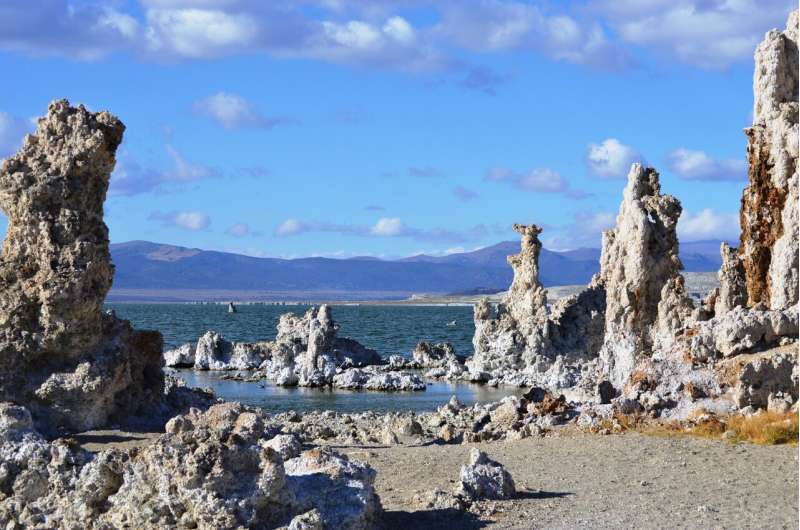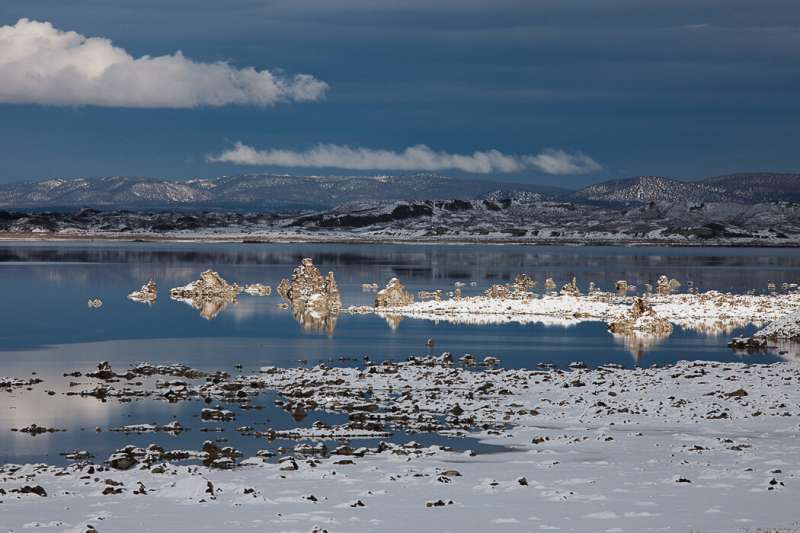Microbes endure a variety of inhospitable conditions in California's Mono Lake

Microbes found across distinct layers in California's Mono Lake may be surviving by using a variety of carbohydrates for energy, according to a recent study.
New research presented last month at the 2019 American Geophysical Union Fall Meeting in San Francisco described bacteria that thrive in the inhospitable lake across a variety of nutrient conditions. Researchers predict that these bacteria, which express more carbohydrate utilization genes than their competitors, succeed by being able to adapt to use available energy sources. The research helps scientists understand how bacteria survive in extreme environments as well as how bacterial communities shift following changes in nutrient levels.
Mono Lake is a saline soda lake located on the eastern edge of the Sierra Nevada, a few miles outside of Yosemite National Park. Compared to the ocean, the water in the lake has over twice as much salt, is 50 times as basic, and has 600 times as much arsenic. Yet life still manages to thrive in these inhospitable conditions: algae, brine shrimp, and alkali flies all call this lake home. Additionally, there are microbial communities hidden in the water's depths.
Even stranger environmental conditions arose during recent years because of heavy snowfalls and a large inflow of freshwater into Mono Lake. Because the water in the lake is so salty, the freshwater forms a distinct layer on top.
"It's just like oil and water," said John Tracey, a graduate researcher at Princeton University who presented the work. This phenomenon, where distinct water layers form in lakes, is known as meromixis. Up until now, researchers haven't known how meromixis affects microbial communities in Mono Lake.
"Oxygen from the atmosphere can't be stirred into the lake by wind," Tracey said. "The surface is oxygenated but at the bottom of the lake, as far as our sensor tells us, there's no oxygen." There are differences in the levels of other dissolved nutrients as well.

In the new study, researchers wanted to explore the different types of microbes populating these different layers of Mono Lake. They collected water samples from different depths and extracted DNA from everything floating around in each sample. They then used next-generation DNA sequencing and computer algorithms to assemble the genomes of the bacteria present in the lake—to get "both who is there and what metabolisms they're doing," Tracey said.
The researchers also analyzed samples from different years to explore whether microbial communities changed before and after meromixis occurred.
They identified different "bins," groups of related bacteria that may correspond with a single microbial species—the researchers can't yet differentiate if a bin corresponds to one species or multiple highly-related species. But even without being able to identify bacteria by species, they found something surprising.
"One of the first things that stood out is this order, Nitriliruptorales, is found it all the depths and all the times at really high abundance," Tracey said. The order Nitriliruptorales was described for the first time in 2009 from bacterial strains isolated from soda lakes and soda soils. The researchers identified nine Nitriliruptorales bins and found one group that dominated all others. These microbes thrived at all depths, even when Mono Lake had distinct water layers with different levels of oxygen and other nutrients.
The researchers looked more closely at the genes being expressed by the different microbial groups and found the dominant group had more genes for digesting carbohydrates than other groups. They suspect these dominant bacteria are able to use more types of carbohydrates than their competitors and are flexible in the face of different nutrient conditions, which could help them thrive in the harsh conditions of the lake.
This work adds to what is known about Mono Lake, said Maggie C.Y. Lau, a microbiologist at the Institute of Deep-Sea Science and Engineering of the Chinese Academy of Sciences who was not involved in the research. There's still more to be gleaned from the sequencing data, she added.
"Having metagenomic data coupled with geochemistry data will really help us to understand the whole ecosystem," she said.
More information: D. Yu. Sorokin et al. Nitriliruptor alkaliphilus gen. nov., sp. nov., a deep-lineage haloalkaliphilic actinobacterium from soda lakes capable of growth on aliphatic nitriles, and proposal of Nitriliruptoraceae fam. nov. and Nitriliruptorales ord. nov., INTERNATIONAL JOURNAL OF SYSTEMATIC AND EVOLUTIONARY MICROBIOLOGY (2009). DOI: 10.1099/ijs.0.002204-0
Provided by American Geophysical Union
This story is republished courtesy of AGU Blogs (http://blogs.agu.org), a community of Earth and space science blogs, hosted by the American Geophysical Union. Read the original story here.



















